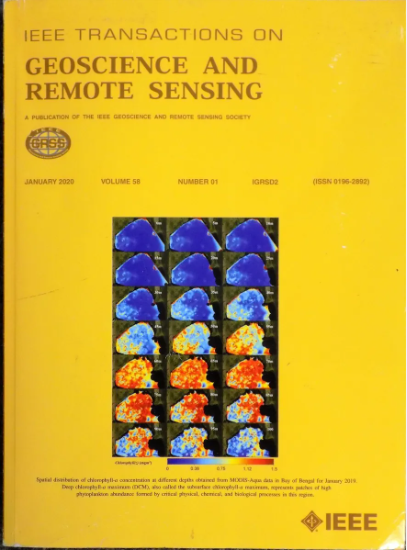多尺度失衡的任意方向 SAR 舰船探测方法
IF 7.5
1区 地球科学
Q1 ENGINEERING, ELECTRICAL & ELECTRONIC
IEEE Transactions on Geoscience and Remote Sensing
Pub Date : 2025-04-14
DOI:10.1109/TGRS.2025.3559701
引用次数: 0
摘要
由于合成孔径雷达(SAR)图像的多尺度不平衡和SAR成像的特点,使得任意方向的舰船检测比光学舰船检测更具有挑战性。与光学图像不同,SAR数据通常缺乏丰富的纹理和颜色线索,而是表现出不均匀的散射、斑点噪声和非标准的椭圆船舶形状,所有这些都使得鲁棒特征提取和边界盒回归在不同尺度上变得更加困难。为了解决这些独特的sar特有的挑战,本文提出了多尺度动态特征融合网络(MSDFF-Net),旨在从三个主要方面缓解多尺度不平衡。首先,多尺度大核卷积块(MSLK-Block)将大核卷积与划分的异构操作相结合,增强了多尺度特征表示,解决了噪声条件下大范围船舶尺寸的问题。其次,动态特征融合块(DFF-Block)通过自适应平衡空间信息和航道信息来处理基于尺度的特征利用不平衡,从而降低杂波干扰,增强对不同尺度船舶的识别能力。第三,我们提出了高斯概率分布(GPD)损失函数,该函数模拟了船舶的椭圆散射特性,减轻了不同尺度和方向目标的回归损失不平衡。在R-SSDD、R-HRSID和CEMEE数据集上的实验评估表明,MSDFF-Net达到了顶级性能标准,优于现有的21种基于深度学习(DL)的SAR船舶探测器。具体而言,MSDFF-Net在R-SSDD数据集上实现了93.95%的精度、94.72%的召回率、91.55%的平均精度(mAP)、94.33%的$F1$ -score和135.79帧/秒(FPS),参数大小仅为8.94 m。此外,MSDFF-Net在大尺度SAR图像之间具有很强的可移植性,适合实际部署。代码和数据集可以在https://github.com/SZZ-SXM/MSDFF-Net公开访问本文章由计算机程序翻译,如有差异,请以英文原文为准。
Arbitrary-Direction SAR Ship Detection Method for Multiscale Imbalance
The arbitrary-oriented ship detection in synthetic aperture radar (SAR) imagery remains especially challenging due to multiscale imbalance and the characteristics of SAR imaging, a problem that is more pronounced than in optical ship detection. Unlike optical images, SAR data often lack rich textural and color cues, instead exhibiting nonuniform scattering, speckle noise, and nonstandard elliptical ship shapes, all of which make robust feature extraction and bounding box regression significantly more difficult across different scales. To address these unique SAR-specific challenges, this article proposes the multiscale dynamic feature fusion network (MSDFF-Net) aims to alleviate multiscale imbalance in three main ways. First, a multiscale large-kernel convolutional block (MSLK-Block) integrates large-kernel convolutions with partitioned heterogeneous operations to enhance the multiscale feature representation, tackling wide-ranging ship sizes under noisy conditions. Second, a dynamic feature fusion block (DFF-Block) handles scale-based feature utilization imbalance by adaptively balancing spatial and channel information, thereby reducing interference from clutter and strengthening discrimination for diverse-scale ships. Third, we propose the Gaussian probability distribution (GPD) loss function, which models ships’ elliptical scattering properties and mitigates regression loss imbalance for targets of varying scales and orientations. Experimental evaluations on the R-SSDD, R-HRSID, and CEMEE datasets demonstrate that MSDFF-Net reaches top-tier performance standards, outperforming 21 existing deep learning (DL)-based SAR ship detectors. Specifically, MSDFF-Net achieves 93.95% precision, 94.72% recall, 91.55% mean average precision (mAP), 94.33% $F1$ -score, and 135.79 frames/s (FPS) on the R-SSDD dataset, with a parameter size of only 8.94 M. In addition, MSDFF-Net exhibits strong transferability across large-scale SAR images, making it suitable for real-world deployment. The code and datasets can be accessed publicly at: https://github.com/SZZ-SXM/MSDFF-Net
求助全文
通过发布文献求助,成功后即可免费获取论文全文。
去求助
来源期刊

IEEE Transactions on Geoscience and Remote Sensing
工程技术-地球化学与地球物理
CiteScore
11.50
自引率
28.00%
发文量
1912
审稿时长
4.0 months
期刊介绍:
IEEE Transactions on Geoscience and Remote Sensing (TGRS) is a monthly publication that focuses on the theory, concepts, and techniques of science and engineering as applied to sensing the land, oceans, atmosphere, and space; and the processing, interpretation, and dissemination of this information.
 求助内容:
求助内容: 应助结果提醒方式:
应助结果提醒方式:


